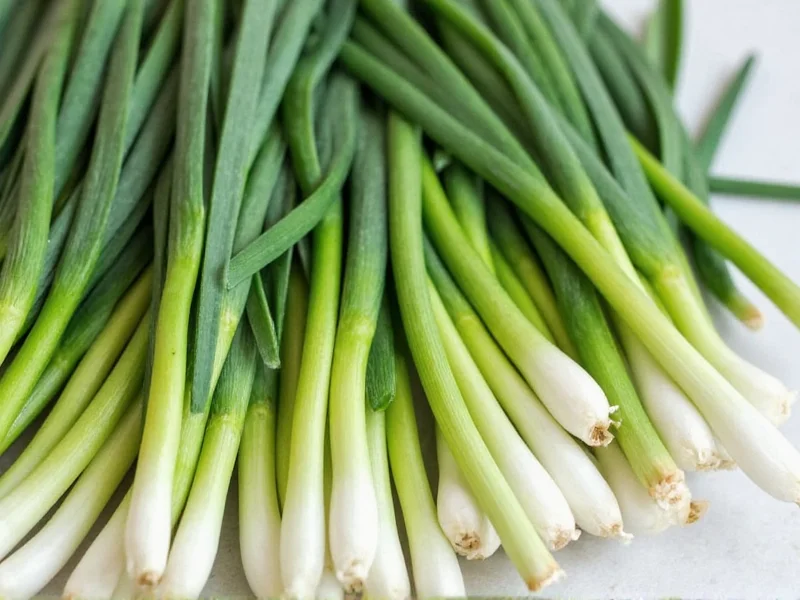When navigating the produce section or following a recipe, confusion between chives and green onions is common. Both belong to the Allium family but represent different species with unique characteristics that affect flavor, texture, and culinary applications. Let's explore the key distinctions to help you use each correctly in your cooking.
Botanical Classification and Physical Characteristics
Chives (Allium schoenoprasum) are perennial herbs native to Europe, Asia, and North America. They grow in dense clumps of thin, completely hollow, round green stems without any bulb formation. The entire plant remains green from top to bottom, typically reaching 8-20 inches in height.
Green onions, also known as scallions, represent either immature bulb onions (Allium cepa) or the perennial bunching onion (Allium fistulosum). They feature a distinctive white bulbous base that gradually transitions to green stalks. The white portion is actually an undeveloped bulb, and the green stalks are solid rather than hollow.
| Characteristic | Chives | Green Onions |
|---|---|---|
| Botanical Name | Allium schoenoprasum | Allium fistulosum or Allium cepa (immature) |
| Stem Structure | Completely hollow, uniform diameter | Solid, with thickening white base |
| Color Transition | Uniform green throughout | White base transitioning to green |
| Flavor Intensity | Mild, delicate onion flavor | Stronger, more pronounced onion taste |
| Typical Culinary Use | Raw garnish, finishing touch | Both raw and cooked applications |
Flavor Profile Comparison
The difference between chives and green onions becomes immediately apparent when tasting them. Chives offer a subtle, grassy onion flavor that enhances dishes without overwhelming other ingredients. Their delicate taste makes them ideal for finishing dishes rather than cooking.
Green onions deliver a more robust onion flavor, particularly in the white base portion. The green tops are milder but still stronger than chives. This intensity allows green onions to withstand cooking better than chives, which lose their delicate flavor when exposed to high heat.
Culinary Applications and Substitution Guidance
Understanding how to tell chives from green onions matters significantly in the kitchen. Chives work best as a fresh garnish for dishes like baked potatoes, soups, salads, and creamy sauces. Their delicate flavor disappears when cooked, so chefs typically add them at the very end of preparation.
Green onions have broader culinary applications. You can use the white portions in stir-fries, sautés, and other cooked dishes where their stronger flavor holds up to heat. The green portions work well as garnishes similar to chives, though with a more pronounced onion taste.
When substituting one for the other:
- If replacing chives with green onions, use only the green portions and reduce the quantity by about 25% due to the stronger flavor
- If substituting chives for green onions in cooked dishes, expect a much milder result and consider adding a small amount of onion powder for depth
- For raw applications, chives make an acceptable substitute for green onions when used in slightly larger quantities
Nutritional Differences
Both chives and green onions offer nutritional benefits, though their profiles differ slightly due to their growth stages and plant structures. Per 100 grams:
- Chives contain higher concentrations of vitamin K (212.7 mcg vs 0.5 mcg) and vitamin C (58.1 mg vs 18.8 mg), making them particularly beneficial for bone health and immune function
- Green onions provide more dietary fiber (2.6g vs 2.5g) and contain slightly higher levels of certain antioxidants due to their more developed bulb structure
- Both are low-calorie options (30 calories per 100g for chives, 32 for green onions) and excellent sources of beneficial organosulfur compounds
Common Misconceptions Clarified
Several myths persist about these allium varieties. Many people wonder are scallions the same as chives—they're not. Scallions is simply another name for green onions, not chives.
Another frequent question is whether the white part of green onions is edible—it absolutely is, and it contains the strongest flavor. Some cooks mistakenly discard this portion, missing out on valuable culinary potential.
When considering chives vs green onions taste comparison, remember that chives' mildness makes them unsuitable as a direct replacement in recipes calling for green onions, especially in cooked dishes where their flavor disappears.
Practical Identification Tips
To avoid confusion at the grocery store:
- Examine the base: chives have no bulb and remain uniformly thin and green, while green onions show a distinct white bulbous end
- Check the cross-section: cut a small piece—chives will be completely hollow, green onions solid
- Smell test: green onions emit a stronger onion aroma than the subtle fragrance of chives
- Consider the packaging: chives typically come in small bunches with rubber bands, green onions in larger bundles often with roots attached
Understanding these differences between chives and green onions ensures you select the right ingredient for your culinary creations. While they share family ties in the Allium genus, their unique characteristics make each valuable for specific applications in the kitchen. Proper identification helps prevent recipe failures and enhances your cooking precision.











 浙公网安备
33010002000092号
浙公网安备
33010002000092号 浙B2-20120091-4
浙B2-20120091-4